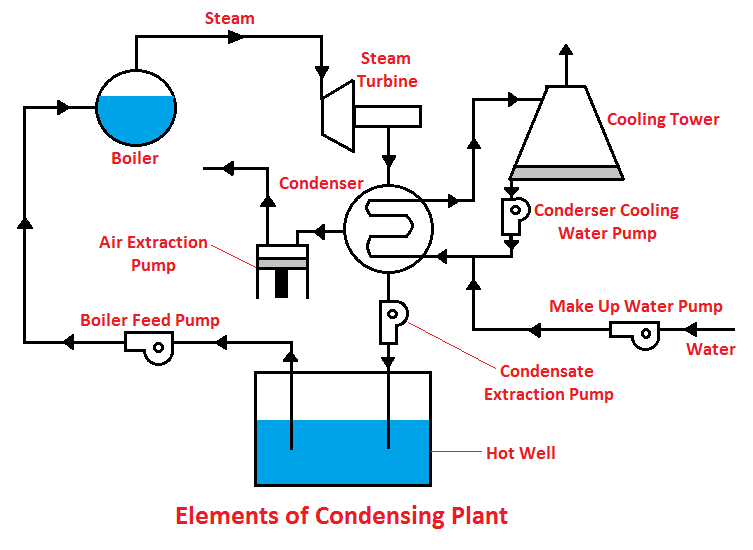In this article, you will learn what is Steam Condenser and It’s working principle, advantages and types of steam condenser with PDF.
Steam Condenser and Types
A steam condenser is a closed vessel in which steam is condensed by abstracting the heat by cooling it with water and where the pressure is maintained below atmospheric pressure.
The condensed steam is known as condensate. The efficiency of the steam power plant is increased by the use of a condenser. The steam condenser is an essential component of all modern steam power plants.
Objectives of the Steam Condenser
A steam condenser has the following two objectives:
- The primary objective is to maintain a low pressure (below atmospheric pressure) so as to obtain the maximum possible energy from steam and thus to secure a high efficiency.
- The secondary objective is to supply pure feed water to the hot well, from where it is pumped back to the boiler.
Elements of a Condensing Plant
The essential elements of a steam condensing plant are as shown in the figure. It includes:

1. Condenser
The condenser is a closed vessel in which steam is condensed. During the condensation process, steam gives heat energy to the coolant (which is water).
2. Condensate Pump
It is a pump, which removes condensate (i.e. condensed steam) from a condenser to a hot well.
3. Hot Well
It is a pump between the condenser and boiler, which receives condensate pumped by the condensate pump.
4. Boiler Feed Pump
Boiler feed pump pumps the condensate from a hot well to a boiler. This is done by increasing the condensate pressure above the boiler pressure.
5. Air Extraction Pump
Air extraction pump is a pump which extracts (i.e. removes) air from the condenser.
6. Cooling Tower
The cooling tower is a tower employed for cooling the water which is discharged from the condenser.
7. Cooling Water Pump
The cooling water pump is a pump, which circulates the cooling water through the condenser.
Read Also: Boiler Mountings and Accessories: Types, Working.
Working of Steam Condenser
The steam condenser receives exhaust steam from one end and gets in contact with the cooling water flowed within it form the cooling tower.
As the low-pressure steam comes in contact with the cooling water, it condenses and turns into water. It is attached to the air extraction pump and condensation extraction pump. After condensation of steam, the condensate is pumped into the hot well by the help of condensate extraction pump.
The air extraction pump extracts air from the condenser and produces a vacuum inside it. The vacuum produced helps in the circulation of cooling water and the flow of condensate downstream.
Types of Steam Condenser
Following are the two main types of steam condenser:
- Jet condensers (mixing type condensers)
- Parallel flow jet condenser
- Counterflow or Low-level jet condenser
- Barometric or High-level jet condenser
- Ejector Condenser
- Surface condensers (non-mixing type condensers)
- Downflow surface condenser
- Central flow condenser
- Regenerative condenser
- Evaporative condenser
1. Jet Condensers
In jet condensers, there is direct contact between the cooling water and the steam that is to be condensed. Steam escapes with the cooling water and the recovery of the condensate for re-use, as boiler feed water is not possible.
Types of Jet Condensers
- Parallel flow jet condenser
- Counterflow or Low-level jet condenser
- Barometric or High-level jet condenser
- Ejector Condenser
(a) Parallel Flow Jet Condensers
In parallel flow jet condensers, both the steam and water enter at the top and the mixture is removed from the bottom.

The principle of this condenser is shown in the figure. The exhaust steam mixes up with the water and condensed. Condensate, cooling water and airflow downwards and are removed by two separate pumps known as an air pump and condensate pump. The condensate pump carries the condensate to the hot well.
(b) Low-level Jet Condenser or Counter Flow Jet Condenser
A low-level or counter-flow jet condenser is shown in the figure. In these types of steam condenser, the cooling water enters at the top and sprayed through jets. The steam enters at the bottom and mixes with the fine spray of cooling water. A separate pump removes the condensate.

The air is removed by an air pump separately from the top. In a parallel flow type of this condenser, the cooling water and steam to be condensed move in the same direction. (i.e. from top to bottom).
(c) High-level Jet Condenser (or) Barometric Jet Condenser
A high-level jet condenser is shown in the figure. This is similar to the low-level condenser, except the condenser shell is placed at a height of 10.36 m (barometric height) above the hot well. In this condenser, the cooling water enters at the top and sprayed through jets.

The steam enters the bottom and mixes with the fine spray of cooling water. The column of water in the tailpipe forces the condensate into the hot well by gravity.
(d) Ejector Condenser
An ejector condenser is shown in the figure. In this condenser, cooling water under ahead of 5 to 6 m. enters at the top of the condenser and it is passed through a series of convergent nozzles. There is a pressure drop at the throat of the nozzle.

The reduction in pressure draws exhaust steam into the nozzle through a non-return valve. Steam is mixed with water and condensed. In the converging cones, pressure energy is partly converted into kinetic energy. In diverging cones, the kinetic energy is partly converted into pressure energy. The pressure obtained is higher than atmospheric pressure and this forces the condensate to the hot well.
2. Surface Condensers
In surface condensers, there is no direct contact between the cooling water and the steam that is to be condensed. The heat transfer between steam and cooling water is by conduction and convection. The condensate can be recovered for re-use as feed water.
Types of Surface Condenser
- Downflow surface condenser
- Central flow condenser
- Regenerative condenser
- Evaporative condenser
(a) Downflow Surface Condenser (Two-pass surface condenser)
The figure shows a two-pass downflow surface condenser. This arrangement is compact and the heat exchange is more efficient. The surface condenser has a great advantage over the jet condensers, as the condensate does not mix up with the cooling water.
As a result of this, the whole condensate can be reused in the boiler. This types of steam condenser can be used when the supply of cooling water is limited. It consists of a horizontal cast-iron cylindrical vessel packed with tubes, through which the cooling water flows.

The ends of the condenser are cut off by vertical perforated type plates into which, the water tubes are attached. The condensate extraction pump, which is located at the bottom, creates suction. The exhaust steam enters from the top and flows over a nest of tubes.
The cooling water enters at the bottom tubes and leaves through the upper half of the tubes. A section of tubes is screened by providing a baffle. This reduces the amount of water vapour escaping with air.
(b) Central Flow Condenser
In the central flow condenser, steam enters the top of the condenser and flows downward. In this suction pipe of the air extraction pump at the centre of the tube nest.
Due to this placement of the suction pipe at the centre of the tube nest, and the exhaust steam passes radially inside over the tubes towards the suction pipe. The condensate is collected at the bottom of the condenser and pumped into the hot well.
(c) Regenerative Condenser
In the regenerative surface condenser, the condensate is heated using the regenerative method. In it, the condensation passes through the exhaust steam emitted from the turbine or engine. It raises its temperature and is utilised as feedwater for boilers.
(d) Evaporative condenser
Evaporative condenser is another type of surface condenser. When the supply of cooling water is limited, evaporating the circulating water under small partial pressure can reduce its quantity required for condensing the steam. This principle is employed in evaporative condensers.

The exhaust steam from the steam engine or steam turbine enters at the top of a series of pipes outside of which a film of cold water is falling. At the same time, a stream of air rotates above the water film, causing rapid evaporation of some of the cooled water.
As a result of this, the steam circulating inside the pipe is condensed. The coolant pump draws water from a cooling pond and forces it to a horizontal header. The header is provided with a number of spray nozzles. Hence the cooling water is sprayed over the finned pipes.
A portion of cooling water is evaporated as it flows over the finned tubes by taking its latent heat from the steam. The remaining water drips back to the cooling pond.
Advantages and disadvantages of jet condensers:
Advantages
- Intimate mixing of steam and cooling water.
- Quantity of cooling water required is less.
- Simple equipment and cost are low.
- Less space is required.
- The cooling water pump is not needed in the low-level jet condenser. Condensate extraction pump is not needed for high level and ejector condensers.
Disadvantages
- Condensate is wasted.
- The cooling water should be clean and free from harmful impurities,
- In low-level jet condensers, the engine may remain flooded, if condensate extraction pump fails.
Advantages and disadvantages of surface condensers
Advantages
- The maximum vacuum can be attained and it gives the highest thermal efficiency.
- Any type of cooling water can be used.
- Water supply is not affected by a drop in vacuum.
- The condensate can be reused in the boiler for raising steam.
Disadvantages
- It is heavier in construction
- It requires more space for its erection
- Capital running and maintenance costs are considerably higher.
Comparison of jet and surface condenser
| SI.no. | Jet Condenser | Surface Condenser |
| 1. | Cooling water and steam mixed up | Cooling water and steam are not mixed up |
| 2. | It is less suitable for high capacity plants | It is more suitable for high capacity plants |
| 3. | Condensation is wasted | Condensate is reused |
| 4. | It requires less quantity of circulating water | It requires a large quantity of circulating water |
| 5. | The condensing plant is economical and simple | The condensing plant is costly and complicated |
| 6. | Maintenance cost is low | Maintenance cost is high |
| 7. | More power is required for air pump | Less power is required for air pump |
| 8. | High power is required for water pumping | Low power is required for water pumping |
That’s it, thanks for reading. If you have any questions about “Types of Steam Condenser” ask in the comments section below. If you found this post helpful share with your friends.
Download PDF file of this article
Read Next:
